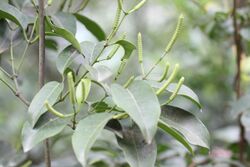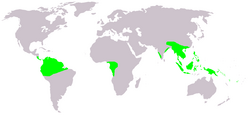Biology:Gnetum
| Gnetum | |
|---|---|

| |
| Gnetum luofuense in China | |
| Scientific classification | |
| Kingdom: | Plantae |
| Clade: | Tracheophytes |
| Clade: | Gymnospermae |
| Division: | Gnetophyta |
| Order: | Gnetales Mart |
| Family: | Gnetaceae Blume |
| Genus: | Gnetum L. |
| Type species | |
| Gnetum gnemon | |

| |
| Distribution | |
| Synonyms[1] | |
| |
Gnetum is a genus of gymnosperms, the sole genus in the family Gnetaceae within the Gnetophyta. They are tropical evergreen trees, shrubs and lianas. Unlike other gymnosperms, they possess vessel elements in the xylem. Some species have been proposed to have been the first plants to be insect-pollinated as their fossils occur in association with extinct pollinating scorpionflies.[2] Molecular phylogenies based on nuclear and plastid sequences from most of the species indicate hybridization among some of the Southeast Asian species. Fossil-calibrated molecular-clocks suggest that the Gnetum lineages now found in Africa, South America and Southeast Asia are the result of ancient long-distance dispersal across seawater.[3][4]
Their leaves are rich in bioactive[clarification needed] compounds such as flavonoids and stilbenes.[citation needed] Of the species studied so far, Gnetum have photosynthetic and transpiration capacities which are considerably lower than those of other seed plants, due to the absence of multiple chloroplast genes essential for photosynthesis, a trait they seem to share with the other living members of Gnetophyta, Ephedra and Welwitschia, as well as conifers.[5] There are over 50 different species of Gnetum.[citation needed]
Species
| Phylogeny of Gnetum[6] | |||||||||||||||||||||||||||||||||
|
| Phylogeny of Gnetum[7][8] | |||||||||||||||||||||||||||||||||||||||||||||||||||||||||||||||||||||||||||||||||||||||||||||||||||||||||||||||||||||||||||||||||||||||||||||||||||||||||||||||||||||||||||||||||
|
There are over 50 different species of Gnetum.
- Gnetum interruptum Biye
- Gnetum latispicum Biye
- Gnetum sect. Gnetum
- Gnetum subsect. Gnetum - 2 species of trees; Southeast Asia, Pacific Islands
- Gnetum gnemon - Tibet, Yunnan, Assam, Indochina, Nicobar Islands, Malaysia, Indonesia, Philippines , New Guinea, Melanesia, Micronesia
- Gnetum costatum - New Guinea, Solomon Islands
- Gnetum subsect. Micrognemones - 2 species of lianas; tropical west Africa
- Gnetum africanum - central Africa from Cameroon to Angola
- Gnetum buchholzianum - central Africa from Nigeria to Zaire
- Gnetum subsect. Araeognemones - 9 species of lianas; tropical South America and Central America - Ituá
- Gnetum camporum - Venezuela
- Gnetum leyboldii - Costa Rica, Panama, Venezuela, Colombia, Ecuador, Peru, Amazonian Brazil
- Gnetum nodiflorum - Guianas, Venezuela, Colombia, Ecuador, Peru, northwestern Brazil
- Gnetum paniculatum - Guianas, Venezuela, northwestern Brazil
- Gnetum schwackeanum - Amazonas State of southern Venezuela, northwestern Brazil
- Gnetum urens - Guianas, Venezuela, Peru, northwestern Brazil
- Gnetum venosum - Bolívar State of southern Venezuela, northwestern Brazil
- Gnetum subsect. Gnetum - 2 species of trees; Southeast Asia, Pacific Islands
- Gnetum sect. Scandentia [Gnetum sect. Cylindrostachys] - about 20 species of lianas; southern Asia
- Gnetum subsect. Stipitati
- Gnetum arboreum - Luzon in Philippines
- Gnetum contractum - southern India
- Gnetum edule - southern India
- Gnetum gracilipes - Yunnan + Guangxi in China
- Gnetum latifolium - Assam, much of Southeast Asia, New Guinea, Bismarck Archipelago
- Gnetum montanum - Himalayas, southern China, northern Indochina
- Gnetum oblongum - Bangladesh, Myanmar
- Gnetum pendulum - Tibet, southern China
- Gnetum tenuifolium - Peninsular Malaysia, Thailand, Sumatra
- Gnetum ula
- Gnetum subsect. Sessiles
- Gnetum acutum - Sarawak
- Gnetum bosavicum - Papua New Guinea
- Gnetum catasphaericum - southern China
- Gnetum chinense Yang, Liu & Zhang
- Gnetum cleistostachyum - southern China
- Gnetum cuspidatum - Indochina, Indonesia, Malaysia, Philippines
- Gnetum diminutum - Borneo
- Gnetum formosum - Vietnam
- Gnetum giganteum - Guangxi in China
- Gnetum globosum - Pahang in Malaysia
- Gnetum gnemonoides - New Guinea, Bismarck Archipelago, Indonesia, Philippines
- Gnetum hainanense - southern China
- Gnetum klossii - Sabah
- Gnetum leptostachyum - Laos, Thailand, Vietnam, Borneo
- Gnetum loerzingii - Sumatra
- Gnetum luofuense - Fujian, Guangdong, Jiangxi
- Gnetum macrostachyum - Indochina, Indonesia, Malaysia, New Guinea
- Gnetum microcarpum - Myanmar, Thailand, Malaysia, Borneo, Sumatra
- Gnetum neglectum - Borneo
- Gnetum oxycarpum - Sumatra
- Gnetum parvifolium - Laos, Vietnam, southern China
- Gnetum raya - Borneo
- Gnetum ridleyi - Peninsular Malaysia
- Gnetum subsect. Stipitati
Uses
Many Gnetum species are edible, with the seeds being roasted, and the foliage used as a leaf vegetable.[9] The plant is harvested and yields a useful fiber.[clarification needed] There is no sense of danger in consuming the fruit or the seeds.[10]
There is also a study done on the plant to see if it has any medicinal properties, finding some anti-coagulation effects due to its stilbenoid content. The family Gnetaceae is well known as a rich source of plant-derived stilbenoids as well as Cyperaceae, Dipterocarpaceae, Fabaceae, and Vitaceae.[11]
Conservation
Some species of Gnetum are in danger of dying out. The habitats are being removed with the trees being cut down to create industry. The tropical rainforest are being destroyed so many of the species are going extinct such as Gnetum oxycarpum. The rainforests are being torn down and being turned into farmland. Gnetum live in only a small part of the rainforest.
Gallery
-
Gnetum gnemon carpellate/female cones
-
Gnetum latifolium staminate/male cones
-
Gathered leaves of Gnetum africanum
-
Gnetum gnemon seeds
References
- ↑ Kew World Checklist of Selected Plant Families
- ↑ Ren D, Labandeira CC, Santiago-Blay JA, Rasnitsyn A, Shih CK, Bashkuev A, Logan MA, Hotton CL, Dilcher D. (2009). Probable Pollination Mode Before Angiosperms: Eurasian, Long-Proboscid Scorpionflies. Science, 326 (5954), 840-847. doi:10.1126/science.1178338
- ↑ Won H, Renner SS: The internal transcribed spacer of nuclear ribosomal DNA in the gymnosperm Gnetum. Molecular Phylogenetics and Evolution 2005, 36:581-597. doi:10.1016/j.ympev.2005.03.011
- ↑ Won, H., and S. S. Renner. 2006. Dating dispersal and radiation in the gymnosperm Gnetum (Gnetales) – clock calibration when outgroup relationships are uncertain. Systematic Biology 55(4): 610-622. doi:10.1080/10635150600812619
- ↑ Significance of Photosynthetic Characters in the Evolution of Asian Gnetum (Gnetales)
- ↑ Hou, Chen; Humphreys, Aelys M.; Thureborn, Olle; Rydin, Catarina (April 2015). "New insights into the evolutionary history of Gnetum (Gnetales)". Taxon 64 (2): 239–253. doi:10.12705/642.12. http://dx.doi.org/10.12705/642.12.
- ↑ Stull, Gregory W.Expression error: Unrecognized word "et". (2021). "Gene duplications and phylogenomic conflict underlie major pulses of phenotypic evolution in gymnosperms". Nature Plants 7 (8): 1015–1025. doi:10.1038/s41477-021-00964-4. PMID 34282286. https://www.nature.com/articles/s41477-021-00964-4.
- ↑ Stull, Gregory W. (2021). main.dated.supermatrix.tree.T9.tre. Figshare. doi:10.6084/m9.figshare.14547354.v1. https://figshare.com/articles/dataset/Gene_duplications_and_genomic_conflict_underlie_major_pulses_of_phenotypic_evolution_in_gymnosperms/14547354.
- ↑ Hoe, V.B. and Siong, K.H., "The Nutritional Value of Indigenous Fruits and Vegetables in Sarawak,"Asia-Pacific Journal of Clinical Nutrition, Vol. 8, no. 1, 1998, pp 24-31
- ↑ "Gnetum gnemon | plant | Britannica" (in en). https://www.britannica.com/plant/Gnetum-gnemon.
- ↑ Kloypan, Chiraphat; Jeenapongsa, Rattima; Sri-In, Piyawit; Chanta, Surin; Dokpuang, Dech; Tip-Pyang, Santi; Surapinit, Nattanan (2012). "Stilbenoids from Gnetum macrostachyum Attenuate Human Platelet Aggregation and Adhesion" (in en). Phytotherapy Research 26 (10): 1564–1568. doi:10.1002/ptr.4605. PMID 22511550. https://www.researchgate.net/publication/224284860.
External links
- Gymnosperm Database - Gnetum
- Sorting Gnetum names
- Uses of Gnetum in Africa (FAO)
- Kloypan, Chiraphat & Jeenapongsa, Rattima & Sri-In, Piyawit & Chanta, Surin & Dokpuang, Dech & Tip-Pyang, Santi & Surapinit, Serm. (2012). Stilbenoids from Gnetum macrostachyum Attenuate Human Platelet Aggregation and Adhesion. Phytotherapy research : PTR. 26. 1564-8. 10.1002/ptr.4605.[1]
- https://bsapubs.onlinelibrary.wiley.com/doi/abs/10.1002/j.1537-2197.1916.tb05408.x
- http://www.theplantlist.org/tpl1.1/record/kew-334161...
Wikidata ☰ Q131550 entry
 |
- ↑ "Renaissance" (in en), Wikipedia, 2021-12-08, https://en.wikipedia.org/w/index.php?title=Renaissance&oldid=1059309664, retrieved 2021-12-15





